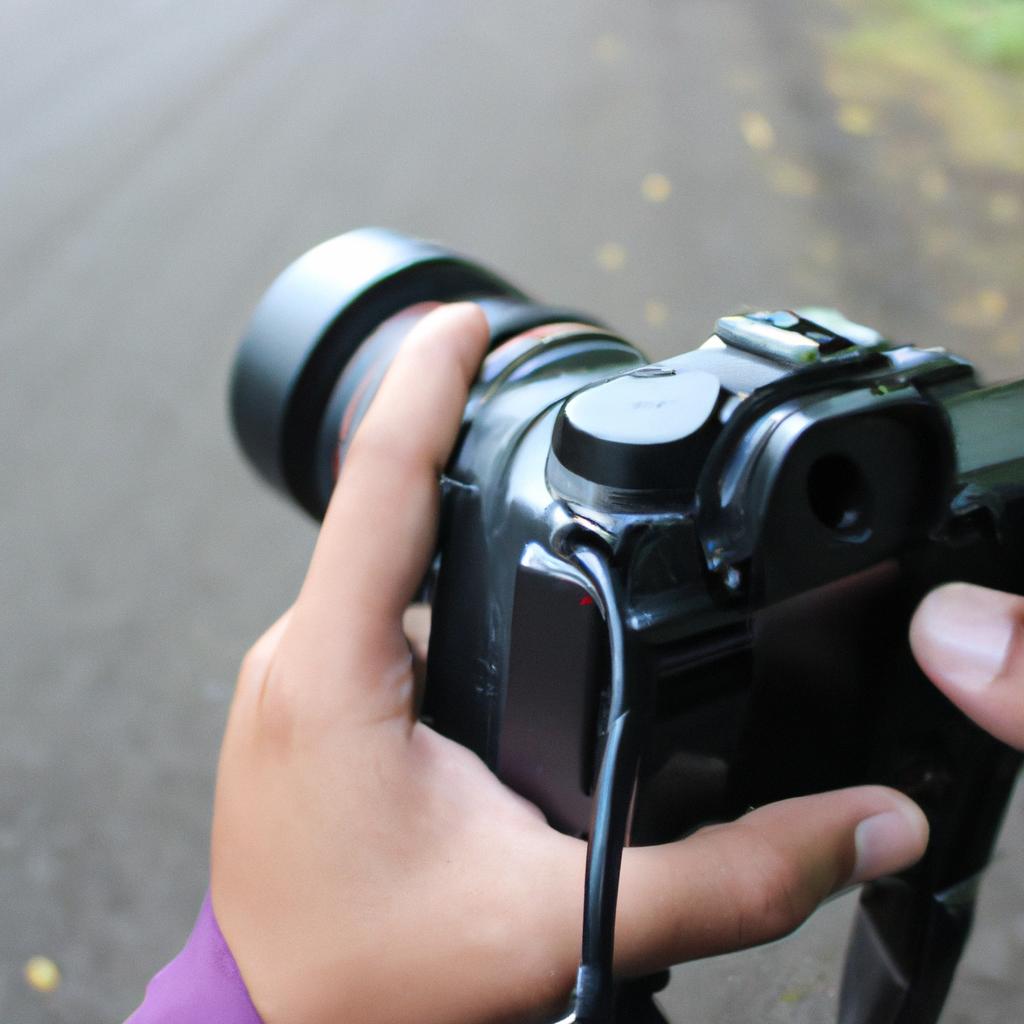Landscape photography has long been a prominent feature in the realm of arts and movies, capturing the beauty and essence of natural environments. This article aims to explore landscape photography from an informational perspective, delving into its significance as both an artistic expression and a storytelling tool within visual media. By examining the ways in which landscapes are portrayed through various mediums, this study seeks to shed light on the transformative power that these images hold.
To illustrate the relevance of landscape photography in arts and movies, let us consider the renowned work of Ansel Adams. Through his masterful use of composition and lighting techniques, Adams was able to capture breathtaking vistas that not only showcased nature’s grandeur but also conveyed a sense of tranquility and awe. His iconic black-and-white photographs served as powerful portrayals of wilderness areas such as Yosemite National Park, igniting public interest and leading to increased conservation efforts. This example demonstrates how landscape photography can transcend mere documentation by evoking emotional responses and inspiring viewers to connect with their surroundings.
In addition to being visually captivating, landscapes often serve as integral elements within cinematic narratives. Filmmakers strategically incorporate sweeping vistas or intimate close-ups of natural scenery to establish mood, enhance character development, or convey symbolic meanings. For instance, in Terrence Mal ick’s film “Days of Heaven,” the vast and breathtaking landscapes of the American Midwest play a central role in conveying the characters’ desires, struggles, and ultimately their fates. The vastness of the prairies reflects the characters’ longing for freedom and escape, while the changing seasons mirror their emotional journeys.
Similarly, landscape photography has been used in documentaries to shed light on environmental issues and raise awareness about conservation efforts. Through capturing images of endangered habitats or documenting the impact of human activity on natural landscapes, photographers and filmmakers can mobilize public support for environmental causes. These visual representations serve as powerful tools for education and advocacy by connecting viewers with nature and inspiring them to take action.
Furthermore, landscape photography allows us to explore our own connection to the natural world. By immersing ourselves in these images, we can experience a sense of awe and wonder, reminding us of our place within a larger ecosystem. In an increasingly urbanized society where many people are disconnected from nature, landscape photography serves as a bridge that reconnects us with the beauty and importance of our natural surroundings.
In conclusion, landscape photography plays a significant role in both arts and movies by capturing the essence of natural environments and evoking emotional responses. Whether through iconic photographs or cinematic portrayals, landscapes have the power to inspire awe, convey narratives, raise awareness about environmental issues, and foster a deeper connection with nature. As such, landscape photography continues to be a valuable artistic expression and storytelling tool within visual media.
Is there anything else you would like to know or discuss?
Historical significance of landscape in art
Historical Significance of Landscape in Art
The significance of landscape in art can be traced back to ancient times, where artists sought inspiration from the natural world around them. One compelling example is the painting “Wanderer above the Sea of Fog” by Caspar David Friedrich, which epitomizes the Romantic era’s fascination with untamed landscapes and individual contemplation. This masterpiece captures a lone figure standing on a rocky precipice, gazing into an undefined distance as nature unfolds before him.
- Awe: Landscapes inspire feelings of reverence and admiration.
- Serenity: Nature scenes provide tranquility amidst chaotic daily lives.
- Reflection: Observing landscapes encourages self-reflection and contemplation.
- Escapism: Immersing oneself in scenic environments offers temporary respite from reality.
In addition to these emotional responses, historical artworks have often employed specific techniques to enhance the impact of landscapes. For instance, artists utilized color palettes that evoked certain moods or used different brushstrokes to convey texture and depth effectively. To exemplify this visually, below is a table showcasing various artistic elements frequently used to depict landscapes:
| Technique | Description | Examples |
|---|---|---|
| Chiaroscuro | Contrast between light and dark | Leonardo da Vinci’s works |
| Impasto | Thick application of paint | Vincent van Gogh’s paintings |
| Atmospheric Perspective | Gradual fading of colors towards the horizon | J.M.W. Turner’s landscapes |
| Golden Ratio | Proportional arrangement for aesthetic harmony | Claude Monet’s compositions |
Considering the historical significance of landscape in art, it becomes evident that its influence extends beyond mere visual representation. Landscapes have captivated artists and viewers alike through their ability to evoke emotional responses and provide a means of contemplation. This connection between humans and nature has also spilled over into other artistic mediums, notably movies—an aspect we will explore further in our discussion on the influence of landscape photography.
Transitioning seamlessly into the subsequent section about “Influence of landscape photography on movies,” it is apparent how landscapes continue to shape creative expressions across various forms of media.
Influence of landscape photography on movies
Building upon the historical significance of landscape in art, it is important to explore how this medium has influenced another creative form – movies. The use of landscape photography in films not only adds visual appeal but also plays a significant role in storytelling and creating emotional connections with audiences.
Influence of Landscape Photography on Movies
Landscape photography has had a profound impact on the world of cinema, shaping the way filmmakers capture outdoor scenes and create narratives that are visually captivating. To illustrate this influence, let us consider a hypothetical scenario where a filmmaker decides to incorporate elements of landscape photography into their movie.
Imagine an epic adventure film set in the rugged mountains of an imaginary land. By drawing inspiration from landscape photographs, the director carefully selects breathtaking locations and meticulously composes each shot to highlight the grandeur and beauty of nature. This attention to detail creates an immersive experience for viewers, transporting them into the protagonist’s journey through vast landscapes filled with wonder and peril.
The incorporation of landscape photography techniques in filmmaking allows directors to manipulate various aspects such as lighting, composition, and depth of field to evoke specific emotions within audience members. Consider these key points:
- Lighting: By harnessing natural light or artificially replicating its effects, filmmakers can enhance mood and atmosphere. A dimly lit forest conveys mystery while a golden sunset over rolling hills evokes warmth and tranquility.
- Composition: Framing shots using principles borrowed from landscape photography helps establish balance, leading lines, and focal points within a scene. These compositional choices guide viewers’ gaze and draw attention to significant story elements.
- Depth of Field: Controlling focus enables filmmakers to emphasize certain subjects against a blurred background or maintain sharpness throughout the frame. Such techniques direct attention towards characters or objects integral to the narrative.
To further understand how landscape photography influences cinematic visuals, consider this comparative table showcasing distinctive features shared by both mediums:
| Aspect | Landscape Photography | Film |
|---|---|---|
| Visual Appeal | Captures the beauty and essence of natural landscapes | Utilizes scenic locations to enhance storytelling visually |
| Emotional Connection | Evokes a sense of awe, tranquility, or other emotions through images | Engages audiences by immersing them in captivating visual narratives |
| Storytelling | Portrays the relationship between humans and their environment | Enhances plot development through the portrayal of outdoor settings |
In summary, landscape photography has greatly influenced cinematic visuals by guiding filmmakers in capturing compelling outdoor scenes. Through careful manipulation of lighting, composition, and depth of field, directors can create emotionally resonant moments that transport viewers into fantastical worlds or explore the depths of human connection with nature.
As we delve deeper into the artistry behind landscape photography’s impact on movies, it becomes essential to understand the techniques and equipment used in this genre.
Techniques and equipment used in landscape photography
In the realm of visual storytelling, landscape photography plays a significant role in influencing movies. By capturing breathtaking scenes and natural beauty, photographers have paved the way for filmmakers to incorporate these elements into their narratives. This section will delve deeper into the techniques and equipment used in landscape photography, shedding light on how they enhance the cinematic experience.
One example that demonstrates the impact of landscape photography on movies is Ridley Scott’s science fiction epic “Blade Runner” (1982). The film showcases futuristic cityscapes inspired by photographs taken by Richard Misrach, an American photographer known for his captivating images of desolate urban landscapes. Misrach’s work provided Scott with a visual reference point and served as inspiration for creating the dystopian atmosphere depicted throughout “Blade Runner.”
To achieve stunning visuals like those found in “Blade Runner,” landscape photographers utilize various techniques and equipment:
- Long Exposure: By using longer exposure times, photographers can capture movement within a scene, such as flowing water or sweeping clouds.
- Wide-angle lenses: These lenses allow photographers to capture expansive vistas and emphasize depth in their compositions.
- Graduated Neutral Density Filters: These filters help balance exposure between bright skies and darker foregrounds, ensuring details are preserved in both areas.
- Tripods: Essential for stability during long exposures or when shooting in low-light conditions.
Markdown bullet-point list:
- Landscape photography techniques create immersive visuals that evoke emotions.
- Capturing serene sunsets paints a picture of tranquility.
- Showcasing rugged mountains instills awe and admiration.
- Documenting vast open spaces evokes feelings of freedom and exploration.
- Revealing hidden gems transports viewers to new worlds.
Markdown table format:
| Technique | Purpose | Example |
|---|---|---|
| Long Exposure | Conveys movement within a scene | Flowing waterfall |
| Wide-angle lenses | Emphasizes depth and captures expansive vistas | Majestic landscapes |
| Graduated Neutral Density Filters | Balances exposure between bright skies and darker foregrounds | Sunset over the ocean |
| Tripods | Ensures stability during long exposures or low-light situations | Nighttime cityscape |
By implementing these techniques and utilizing specific equipment, landscape photographers can create captivating images that evoke strong emotional responses from viewers. These visuals serve as a foundation for filmmakers to transport their audience into imaginative worlds, establishing mood and atmosphere within their narratives.
Understanding the techniques and equipment used in landscape photography allows us to appreciate the work of famous landscape photographers in the film industry who have made significant contributions to cinematic aesthetics.
Famous landscape photographers in the film industry
Building on the techniques and equipment used in landscape photography, it is crucial to explore how this art form has influenced the film industry. By immersing viewers into captivating natural environments, landscape photography enhances storytelling and evokes emotional responses within audiences.
Case Study:
Consider the award-winning movie “The Revenant” directed by Alejandro González Iñárritu. This film masterfully integrates breathtaking landscapes captured through photography to convey a sense of isolation, survival, and human resilience. The vast snowy landscapes depicted throughout the movie create an atmosphere that intensifies the narrative’s themes and emotions.
Bullet Point List (Emotional Response):
- Awe-inspiring vistas transport viewers to picturesque locations.
- Intimate close-ups of nature allow for moments of reflection and contemplation.
- Serene seascapes or rolling meadows evoke feelings of tranquility and peace.
- Harsh or desolate landscapes can generate tension or unease within audiences.
Table (Emotional Response):
| Emotional Response | Examples |
|---|---|
| Wonder | Majestic waterfalls plunging down rocky cliffs |
| Solitude | An empty beach with no signs of human presence |
| Fear | Dark storm clouds looming over a barren desert |
| Excitement | Vibrant fall foliage painting forests with color |
Incorporating these elements effectively allows filmmakers to elicit specific reactions from their audience, enhancing the overall cinematic experience.
Understanding the impact of landscape photography on film production leads us to delve further into its role in storytelling. How does capturing stunning natural scenery contribute to narratives? Let us now explore how landscape photography enhances storytelling in movies…
How landscape photography enhances storytelling in movies
From the works of famous landscape photographers in the film industry, we can clearly see how their artistry and vision have played a significant role in enhancing storytelling. By capturing stunning landscapes on camera, these photographers bring to life the settings that form an integral part of movies. The visual impact created by their photography adds depth and emotion to the narrative, immersing viewers into the world being depicted.
One notable example is the acclaimed cinematographer Roger Deakins, whose collaboration with directors like Joel and Ethan Coen has resulted in visually striking films such as “No Country for Old Men” (2007) and “True Grit” (2010). In both movies, Deakins’ exquisite portrayal of rugged landscapes amplifies the themes of isolation, survival, and perseverance. Through his lens, audiences are transported to vast expanses where characters face formidable challenges against breathtaking backdrops.
The incorporation of landscape photography not only enhances visual aesthetics but also serves multiple purposes within movie narratives. Here are some ways in which it enriches storytelling:
- Setting Atmosphere: Landscape images set the tone and atmosphere for scenes in movies. A serene mountain range or a desolate desert conveys tranquility or loneliness respectively without relying solely on dialogue.
- Symbolism: Landscapes often hold symbolic meanings that contribute to character development or thematic elements in films. For instance, a dense forest might represent mystery or danger while an open field signifies freedom or liberation.
- Emotional Impact: Scenic landscapes evoke emotional responses from audiences. They can create feelings of awe, wonderment, fear, or serenity based on their composition and context within the story.
- Visual Contrast: Contrasting landscapes provide visual juxtapositions that heighten dramatic tension between characters or highlight conflicts between different aspects of nature itself.
To illustrate these points further, let us consider a table showcasing two contrasting examples:
| Film Title | Landscape Image | Purpose |
|---|---|---|
| “The Revenant” | Snow-covered wilderness | Portrays the harshness and isolation of the protagonist |
| “Avatar” | Lush, vibrant alien planet | Represents a pristine environment threatened by humans |
In conclusion, landscape photography plays an essential role in enhancing storytelling in movies. Through their artistic vision, photographers create visual masterpieces that transport audiences into immersive worlds. The incorporation of landscapes adds depth, symbolism, emotional impact, and visual contrast to movie narratives. By utilizing these elements effectively, filmmakers can engage viewers on multiple levels and evoke powerful responses.
Transitioning into the subsequent section about the impact of landscape imagery on audience perception…
Impact of landscape imagery on audience perception
Transitioning from the previous section on how landscape photography enhances storytelling in movies, we now delve into the impact of landscape imagery on audience perception. To illustrate this point, let us consider a hypothetical scenario: imagine watching a movie set in a desolate desert with vast stretches of sand dunes and an endless sky. This depiction of the arid landscape instantly evokes feelings of isolation, emptiness, and perhaps even a sense of awe.
When it comes to audience perception, landscape imagery plays a crucial role in creating emotional connections and setting the overall tone of a scene or film. Here are some key ways in which landscape photography influences our perceptions:
- Atmosphere and Mood: Through careful selection of landscapes, filmmakers can establish specific atmospheres and moods that enhance the narrative’s intended emotions. A majestic mountain range may evoke feelings of grandeur and adventure, while a tranquil beach sunset might elicit relaxation and tranquility.
- Symbolism: Landscapes often serve as powerful symbols within films, representing broader themes or concepts. For instance, an isolated island surrounded by stormy seas could symbolize solitude or struggle.
- Visual Contrast: Contrasting landscapes can provide visual interest and emphasize dramatic moments within the storyline. The juxtaposition between lush green forests and barren wastelands can create tension or highlight significant plot developments.
- Character Development: By integrating characters with various landscapes, filmmakers can convey deeper aspects of their personality or journey. A protagonist traversing through rugged terrain may signify resilience or personal growth.
To further demonstrate these ideas visually:
-
Emotion-evoking bullet list:
- Sense of wonderment
- Feelings of nostalgia
- Intense anticipation
- Overwhelming serenity
-
Emotional response-inducing table:
Landscape Imagery Associated Emotion Snow-covered mountains Awe Dense foggy forest Mystery Vibrant flower fields Joy Abandoned urban ruins Melancholy
In conclusion, landscape photography in movies has a significant impact on audience perception. By effectively utilizing various landscapes, filmmakers can evoke specific emotions, convey deeper meanings, and enhance the overall cinematic experience. Such imagery serves as a powerful tool for storytelling, offering viewers an immersive journey through visual narratives without explicitly stating them.




